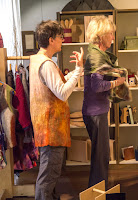A couple of folks (only a couple) have asked when I would
blog about our recent trip to Italy. So
here goes. Those disinterested in a
travel log should bail out now . . . or
at most, click on the pictures.
Ann and I hadn't been in Italy in ten years. Before
that a few times, but not to Florence in 23 years. In the interim I had taken up stonecarving as
a hobby so I wanted to return to Florence
to see with new eyes the Prisoners, Night and Day, Dawn and Dusk, Pietas and,
of course, various Davids. Despite hordes
of tour groups – the emerging middle classes from around the world take to
touring in flocks like ducklings take to water – I was entranced. After a week of dodging tour groups, we were glad to leave Florence behind and seek the peace and novelty of Umbria.
A wildcat rail strike forced us onto a bus to Perugia, which
was cheaper, faster and closer to lovely countryside. (The strike was our
second surprise of what turned out to be three. #1: our carefully selected rental apartment
in Florence had turned sour and we had no accommodations when we arrived on a
Friday afternoon before a beautiful fall weekend, but finally the rental agency rustled up a
lesser loaner that we made work. #3: TSA caused us to miss a flight, but that’s another story. The good news is we’re still able to roll with the punches.)
We had once been in Perugia for about two hours years before, and
it had intrigued me since. Ann assented
to go there and postpone hiking in the Tyrol and Savoy for another time, so now
I owe her. We were welcomed in Perugia
by a beautiful sunset; our room in Albergo Fortuna faced west and a
near-private adjacent patio was lovely
for cocktails or early
morning coffees. The sounds of the city,
of mothers herding kids up and off, of couples murmuring, a woman singing to herself, rose from the tile
roofs below.
Perugia is capitol of Umbria, and a great home base from which to
explore. And there is much to explore and
savor. Sure, Tuscany gets better press; after all,
one can hardly top Florence for its art and as cradle of the Renaissance, or
Siena for the passion of its Palio (and all of it for its tourist crowds and high prices.) Umbria may be more modestly though still
wonderfully well endowed, but she is more accessible, more affordable, and
serves up better food. She makes a better date (but this year,
unfortunately, has come with bigger earthquakes.)
 |
| 13thC Hall of the Notari |
Perugia’s history, like so much of central Italy, is a complex
tapestry of people’s loves and feuds, of conquest and revenge, of Umbrians,
Etruscans, Sabines, Roman republicans, Roman Emperors, Byzantines, Perugian Priors, Florentine colonials, of Popes and Holy Roman Franks, of Risorgimento freedom fighters, of Fascists, of German occupiers, and of Berlusconi bureaucrats. Its ancient, hill-top center is a warren of lanes and by-ways, a
jumble of buildings built upon
buildings, of churches and guild halls, of cobbles and piazzas, with 360 degree
views of the hills and valleys over which it presides.
 |
| A Zucchini Flan |
Food? The fields and
hills of landlocked Umbria, are the "Green Heart of Italy,” rich with white and
black truffles, melanzana, olives, squashes and root vegetables, beans and lentils and
barley, cow and goat cheeses, pigs and lambs, chestnuts – all of which combine
into a simply exquisite regional cuisine of soups, stews, casseroles, osso
bucos, and the like. It’s a
bit lighter on pasta than elsewhere, abundant in cheeses and salumi, plus lots of seafood from Tuscany and the
Marches.
 Art? Etruscan, in a wonderful archeological museum; Roman;
Christian, from the 12thC on; Italian Futurist; a vibrant
Art? Etruscan, in a wonderful archeological museum; Roman;
Christian, from the 12thC on; Italian Futurist; a vibrant
Perugia as home base facilitates great day tripping: half an hour
by train (€3.50) to charming Spello; an hour bus ride (€4) to Assisi,
home town of St.
Francis and St. Clare; Orvieto; Citta di Castello; Lake Trasimeno; Gubbio; Spoleto; and crossing the border into Tuscany, Pienza and Cortona; and lots more. (Full disclosure: I haven’t been to half of these.)
 |
| Wearable Art, made on site in Spello |
 |
| Basilica of St. Francis, Assisi |
A word about the earthquakes: they have done severe damage
to hill towns south and east of Perugia.
We have contributed through the Italian Red Cross’ fund Terremoto Centro Italian. It can use more support; Italian recovery
skills, after all, are – well -- Italian.
I know. I sound like a publicist for Perugia and Umbria. But they
have an under-told tale to tell. Go. Relax,
gaze, linger (as my departed friend Don Marsh used to say,) recuperate, recreate,
rejuvenate, in Umbria.






Fletch ... your early morning coffees and the lingerings ... remind me of what my friend Bruno once said in his writings: "... it is pretty wonderful that even if it is only once in a very long time, you see a couple of people who actually figured out the art of life."
ReplyDelete